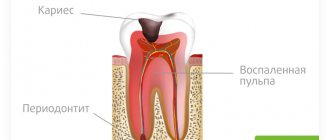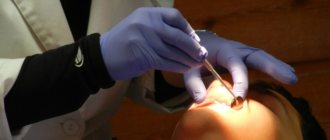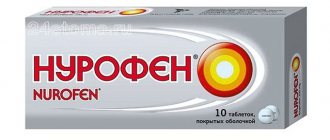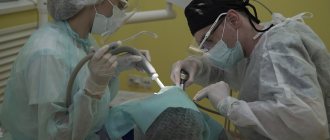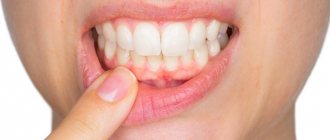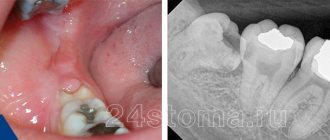Dental treatment is a medical procedure that corrects a smile, corrects imperfections and relieves pain. However, discomfort after dental surgery, in particular after installing a filling, does not go away immediately.
In 90% of cases, mild pain is natural, since the filling affects nerves, canals, and tissues. It takes time for the filling to “take root”. During this period, the pain can be constant, fading or variable, provoked by irritants: hot tea, strong pressure on the gums, etc.
But there are other pains - pathological ones. They require new medical intervention and careful treatment. Let's consider each option in more detail.
What can hurt after filling?
The pain associated with the installation of a filling directly depends on the structure of the tooth. It consists of a crown, neck and root. On top, all these structures are covered with hard dental tissues that do not have nerve endings. In the crown area it is dentin and enamel, in the root area it is cement. Inside, under the hard covering in the crown area, there is a dental cavity filled with pulp - a pulp that has many nerve endings and blood vessels. The cavity is connected to root canals, also filled with pulp. In the area of the apex (apex), the root is connected to the bone tissue of the jaw using a ligament - the periodontal ligament, which has excellent innervation.
Conclusion: a tooth can only hurt if the pulp and periodontium are diseased or injured during filling.
Canal cleaning and filling
The most common cause is caries - a pathological process accompanied by the destruction of hard dental tissues. This opens access to the dental cavity, root canals and periodontal tissue, inflammation or irritation of which causes severe pain.
Preparing a tooth for filling
Filling is a method of treating caries, but this process itself can cause mechanical irritation of soft tissues, accompanied by pain. Minor pain may be normal, but sometimes you cannot do without the help of a specialist.
In the superficial and middle stages of caries, the affected hard tissues are removed and a filling is placed on top, restoring the shape of the tooth. The dental cavity remains closed. This treatment is absolutely painless and does not require anesthesia. An even more effective way is to have your teeth professionally cleaned to remove plaque and tartar. Regular implementation of this procedure prevents the development of caries and allows you to keep all your teeth healthy for a long time.
Tooth preparation and depulpation
With deep caries, a hole forms in the hard tissues and an infection enters the dental cavity, causing intense pain. In such cases, before filling, preparation is carried out to remove damaged hard tissues and expand the cavity. If necessary, the old filling is also removed. Then the pulp is removed (depulping).
This is a painful procedure, but modern local anesthetics used in dentistry allow the patient to experience no pain at all. If deep caries has developed not so long ago, and the periodontal tissues are healthy, then it is possible to remove only the pulp from the dental cavity (amputation), after which a therapeutic lining is applied and a temporary filling is installed. If there is no pain, a permanent filling is placed after a few days.
In case of long-standing caries, the pulp is first completely removed from the dental cavity, and then from the root canals (extirpation). At the same time, the cost of filling increases.
It is very important to carefully remove the pulp (patients often call it the nerve) from the canal, making sure that no particles of destroyed hard tooth tissue remain in it. All this can support a long-term inflammatory process.
If a tooth hurts after canal filling, the infection can gradually reach the root apex, causing an inflammatory process in the periodontium, accompanied by fever and pain.
Rinse for painful sensations
Rinses are also widely used - both homemade and pharmacy. For example:
- 100 ml of water, a teaspoon of soda, a teaspoon of soda, iodine - 5 drops. Used to relieve swelling and remove purulent contents
- 1 spoon of sage per glass of boiling water (decoction), anise - 10 drops. Provides pain relief and has an anti-inflammatory effect.
- 1 glass of warm water, 1 tablet of furacillin. Powerful antibacterial effect, reducing swelling.
The drug chlorhexidine has a good aseptic effect; so-called dental elixirs can be used to relieve pain.
It is important to understand that all the methods listed above are only first aid for toothache; if you stop there, you will soon inevitably need tooth extraction!
To eliminate pain, it is necessary to identify and eliminate the cause of the problem. This can only be done in a dental clinic, where modern equipment ensures comfortable and painless treatment.
Why does a tooth hurt after filling?
If a tooth hurts under a filling, there are usually natural reasons for this - irritation and even a slight aseptic (without infection) inflammatory process. The tooth should hurt after filling. Pain appears after the anesthetic wears off and is associated with restoration of tissue sensitivity. Each patient’s pain sensitivity threshold is different: one feels almost no discomfort, while another perceives the same pain as severe.
Depending on the degree of destruction of the crown and the filling work performed, unpleasant painful sensations after the end of anesthesia can last from 5 days to several months. The doctor must warn the patient that he may be bothered by painful sensations for a certain time and how to cope with them.
There is no need to see a dentist if the pain:
- has a moderate aching character, lasts no more than 5 days and its intensity gradually decreases; during root canal treatment, pain can last from a week to a month; if the filling was traumatic, it may last even longer;
- appears or intensifies when pressing on the filling - biting on solid food;
- associated with eating irritating foods - too cold or hot, as well as sour or sweet; after the effect of irritation ends, the intensity of painful sensations decreases;
- associated with hypothermia;
- is not accompanied by swelling of the cheeks, increased body temperature and a violation of the general condition.
Pain associated with filling errors
Common mistakes: root canal perforation and foreign body entry into the root canal
Post-filling pain syndrome can also be associated with medical errors. This:
- Lack of x-ray examination at the very beginning, before filling . The tooth may have structural features: tortuous canals, the presence of additional canals, etc. Without X-rays, the doctor will not be able to properly process and seal it. This is where the answer to the question of why a tooth hurts after root canal filling lies.
- Incorrect (insufficient or excessive) drying of the prepared cavity . Drying is necessary so that the application of a special solution promotes tight adhesion of the filling material to the dentin of the dental cavity. Insufficient drying leads to disruption of this adhesion, the filling will not fit tightly to the walls, infection will penetrate into the cavity, and inflammation will begin. Overdrying is also harmful, it increases the sensitivity of tissues and post-filling pain syndrome will persist for a long time.
- Overheating of dental tissues. Most often, this complication occurs when the dentist works on old equipment. Tooth preparation is accompanied by strong heating of the bur. If you do not frequently cool the dental tissues, a burn of the pulp or dentin is possible, accompanied by severe pain. Tissue burns are also possible when filling using light-curing filling material and outdated ultraviolet lamps that have not been used for a long time. Modern halogen systems for light curing do not give rise to such complications.
- Failure to comply with preparation rules. Leads to infection, the development of pulpitis and periodontitis and associated pain, which intensifies when biting hard food, perforation may occur: the walls or bottom of the dental cavity; this complication occurs when the walls of the carious cavity are excessively prepared; the bottom of the cavity is most often perforated due to insufficient preparation of the walls, the inability to see and properly process the mouths of the root canals;
- walls of root canals - perforation is usually associated with instrumental treatment of difficult tortuous canals. To reduce pain, you will need to apply therapeutic bandages and completely re-treat the tooth.
- a fragment of a tool used to clean the canal;
To determine why a tooth hurts after filling, specialists at the YuliStom clinic first conduct diagnostics (thorough examination and x-rays) and only then treat.
When should you see a dentist?
Immediately after dental treatment, it is important to be attentive to your condition.
You should immediately consult a doctor at the LEVI-DENT clinic if the following symptoms appear:
- acute fever with increased body temperature;
- swelling and hyperemia of the gums near the treated tooth;
- pronounced swelling of the face;
- pain when biting food;
- putrid breath;
- swelling and distension in the oral cavity;
- infiltration on the gum with the formation of an abscess.
The presence of the above signs indicates the development of infectious tissue damage, which can lead to complications.
What to do if your tooth hurts after filling?
If a tooth begins to hurt due to a filling being placed, but its condition does not require additional dental procedures to relieve severe pain, the doctor may prescribe:
- painkillers ; most often these are drugs from the group of non-steroidal anti-inflammatory drugs (NSAIDs); Ketoprofen (Ketonal) has the best analgesic properties; in case of severe pain, it is enough to take a long-acting capsule of 150 mg - these will relieve pain for a day; instead of Ketonal, you can use the rectal suppository Diclofenac - 100 mg; both drugs are contraindicated in the presence of a gastrointestinal ulcer; in such cases, it is better to take a nimesulide tablet (Nise) - it has almost no negative effect on the gastrointestinal tract;
- physiotherapeutic procedures - to reduce pain, electrophoresis with novocaine is prescribed; for swelling, it is better to use hydrocortisone instead of novocaine; Magnetic and laser therapy are also used; the number of procedures depends on the patient’s condition;
- a one-time injection of an antibiotic solution into the periodontal tissues - for problematic traumatic treatment to prevent infectious inflammation and pain.
There are many folk recipes for relieving severe post-filling toothache:
- rinsing the mouth with a decoction of oak bark; Pour 2 tablespoons of crushed bark into a glass of water, bring to a boil, boil for 15 minutes, add boiled water to the original volume, strain and rinse your mouth several times a day; when a tooth hurts, it relieves inflammation, swelling and associated pain well;
- applying a small piece of salted (but not smoked) lard to the gum - this application is especially helpful for pain associated with tissue swelling: salt draws fluid from the tissue, swelling and pain go away;
- a reflex method of pain relief (used in folk medicine for a very long time): grate a clove of garlic on a fine grater, place it in a thin napkin, apply it to the inside of the wrist of the hand opposite the painful tooth, fix it and leave it overnight.
Medicinal painkillers
The main drug group for the treatment of toothaches is currently drugs from the NSAID group, available both in tablet form and in the form of ointments and gels.
- Ketanov effectively relieves severe pain and has anti-inflammatory and antipyretic effects. The effect develops 20-30 minutes after administration and lasts up to 10 hours, which allows you to reduce the frequency of taking the drug. Prescribed 1 tablet (10 mg) after meals, can be taken again if necessary. The maximum daily dosage is 40 mg (up to 4 tablets per day).
- Kalgel is a dental gel that, when applied topically, has a complex effect. Contains lidocaine, due to which pain is suppressed 5-10 minutes after application to the gingival surface in the area of the diseased tooth. Inhibits the growth and reproduction of bacterial flora, preventing the development of an infectious process in periodontal tissues. Can be applied up to 6 times a day.
When you can and when you can’t tolerate pain after filling
My tooth hurts under a filling, what should I do? First of all, do not panic, but calmly understand the situation. If a tooth hurts after a filling, the nature of the pain and the appearance of some other symptoms matter.
Tooth hurts under temporary filling
The intensity of pain under the temporary filling should gradually decrease
Can a tooth hurt under a temporary filling? Of course, it can, but natural pain is not severe, and its intensity gradually decreases. The tooth hurts after filling, mainly during the day, when it is subjected to one or another impact - pressure (chewing hard food), drinking hot, cold or sour drinks.
- Possible reasons : most often, this is normal, the tooth begins to hurt for natural reasons. Painful sensations can also occur due to overheating of tissues during preparation, light-curing of fillings, problems with drying the dental cavity after preparation, or fillings that are excessive in height.
- What is the best way to relieve pain : for natural pain and pain associated with minor violations of the therapeutic process, it is enough to rinse your mouth with an infusion of chamomile flowers and take an anesthetic (Analgin, Pentalgin, Nise).
Acute pain after filling
Very often, a tooth hurts after root canal cleaning and filling. The acute nature of the pain syndrome is associated with injury or inflammation of sensitive tissues - pulp or periodontium. Much also depends on the pain sensitivity of the patient himself.
- Possible reasons : incomplete removal of pulp from the tooth cavity.
- What is the best way to relieve pain : take a painkiller and see a dentist.
Read more about the causes and methods of eliminating acute pain in the teeth in this article.
Throbbing pain after filling
If the tooth hurts severely after filling, the pain has become throbbing, then this is a sign of inflammation of the pulp - pulpitis. A sharp headache often appears.
- Possible causes : the cause of pulsating pain syndrome may be poor-quality treatment of the dental cavity and root canals, possibly perforation of the walls.
- What is the best way to relieve pain : take any painkiller orally and immediately consult a dentist.
Only a dentist can relieve throbbing pain
Aching pain after filling
When a tooth aches after a filling is placed, this is normal. How long a tooth hurts after canal filling depends on the complexity of the manipulations performed. The intensity of the pain is important: if it increases, the pain intensifies sharply when pressed, then this is a symptom of incipient inflammation. A decrease in intensity is a favorable sign.
- Possible reasons : this is natural pain in a filled tooth.
- What is the best way to relieve pain : rinse with a decoction of oak bark or an infusion of chamomile flowers. If the pain seems too severe, take a pain reliever.
Read about how to eliminate aching toothache here.
Tooth hurts after filling when pressing
If a tooth hurts after a filling when you bite it, then most often it has natural causes and goes away in five to seven days.
- Possible reasons : if after filling a tooth hurts when pressed, then most often this is a consequence of treatment and injury to dental tissues.
- How best to relieve pain : temporarily avoid chewing food on the side of the filling, rinse your mouth with light antiseptics and herbal decoctions.
Poor cleaning of the cavity
In rare cases, when installing a tooth filling, a dentist may simply not notice microscopic areas of carious lesions in the tissues. Despite treating the area with antiseptic drugs, a small amount of pathogenic bacteria may still remain in the tissues of the carious cavity. This will lead to the fact that in a year or two, the enamel in this area will be destroyed and the tooth in which the filling will ache. Often, such processes can occur chronically, without showing any symptoms for years and without needing treatment, and then one day the tooth gives acute pain, indicating the onset of inflammation in the nerve tissues.
When you need to urgently go to the clinic
Occasionally, a filling can create serious problems that require immediate attention to your dentist:
- gum pain after tooth filling; if the pain does not increase, then this is a variant of the norm; but often the pain syndrome is accompanied by redness and swelling of the mucous membrane, the appearance of pus when pressing on the gums, which indicates the presence of an inflammatory process; it could be a burn to the gum tissue, an allergy to the filling material, or an infection; in any case, you need to contact a specialist;
- a toothache and a sharp rise in body temperature to high numbers or a slight increase lasts more than three days, a severe headache appears;
- the cheek on the side of the filling became swollen and pain of any nature, increasing in intensity, appeared in the tooth or periodontal tissues.
Don't put off visiting the dentist if your cheek is swollen or you have a fever!
Treatment of post-filling pain
Home treatment for pain that occurs after filling is fraught with serious complications. If a surgical visit to the doctor has to be postponed for several days (when the pain catches you on vacation or on a business trip), you can temporarily suppress it with the help of:
- rinsing with herbs (decoctions of chamomile, calendula, sage have a calming effect);
- disinfection with antiseptics (rinsing, using spray).
Painkillers and anti-inflammatory drugs should be taken with caution, always in accordance with the instructions.
You should never put off going to the doctor. But in some cases this needs to be done immediately. Delay is dangerous when:
- the pain has become unbearable;
- the temperature has risen;
- inflammation began (gums, cheeks);
- lymph nodes have enlarged;
- abscesses have formed.
Incomplete treatment can lead to serious complications: the development of pulpitis, tissue necrosis, tooth destruction and loss. Therefore, try not to lose contact with your doctor until the post-filling recovery period has passed.
Number of views 5,717
Prevention
The risk of tooth pain after a filling is installed can be reduced if you follow all the dentist’s recommendations for oral care.
What not to do before filling
When planning a visit to the dentist, you need to:
- choose the most suitable time so that you can rest after the filling is placed;
- eat, as you will not be able to eat immediately after treatment;
- Do not drink alcoholic beverages under any circumstances, as they may have undesirable reactions with the painkillers used during treatment;
- Brush your teeth thoroughly and rinse your mouth with an antiseptic solution, such as mouthwash.
You should not plan to place a filling during any acute illness or exacerbation of some chronic disease.
What not to do after filling
It is important to adhere to the following tips:
- do not eat or drink for two hours;
- try to avoid chewing on the affected side of solid food;
- do not eat too hot or cold food for 5 – 7 days;
- avoid coloring products that can change the color of the filling material (beets, red wine, etc.);
- brush your teeth only with a new soft toothbrush twice a day;
- use an alcohol-free mouth rinse;
- do not use dental floss to remove food debris; it is better to replace them with a new product - an irrigator.
Traditional medicine
- Propolis tincture is used as a mouth rinse or application; it effectively relieves pain and prevents the development of inflammation due to essential oils and steroids. To use, a few drops of tincture are applied to a cotton or gauze swab and applied to the diseased tooth for 20-30 minutes until the pain subsides. To rinse, a teaspoon of tincture must be diluted in a glass of boiled water at room temperature and irrigated the oral cavity 4-5 times a day if discomfort occurs in the area of the filled tooth.
- Rinsing the mouth with a solution of baking soda and salt with added iodine after each meal.
- Tincture of valerian and lemon balm has anesthetic and antibacterial properties; these tinctures are used in the form of applications to relieve pain.
- Treating the gingival surface in the area of the treated tooth with clove oil several times a day will significantly reduce pain.
